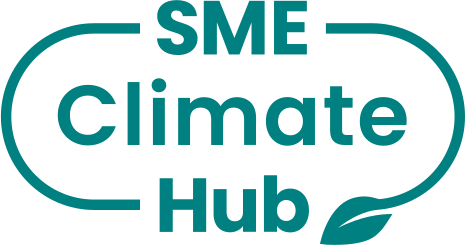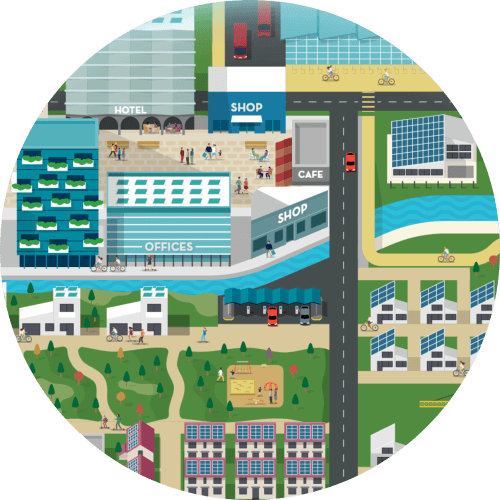Découvrez les étapes que votre entreprise peut suivre vers un avenir plus durable grâce à nos ressources gratuites.
Across the PondRapport sur le climat
Introduction *
Commitment and Targets *
Own Emissions *
Value Chain Emissions *
(optional)Climate Solutions *
(optional)Management, Strategy and Climate Risk *
(optional)Results, Challenges and Outlook *
Introduction *
1.1 Reporting year
*2023
1.1.1 Reporting period
*from 1.2023 to 12.2023
1.2 Describe your business activities
*1.4 Number of employees in the reporting year
*1.4.1 Full-time equivalent (FTE) or headcounts
*1.5 Let us know if your company is a parent company or subsidiary
*Commitment and Targets *
2.1 Net zero target year
*2.1.1 Base year
*2.2 Near-term target
*15% of absolute total emission reduction from my base year by 2026
25 of absolute scope 1+2 emission reduction from my base year by 2026
40 of absolute total emission reduction from my base year by 2027
50 of absolute total emission reduction from my base year by 2028
75 of absolute total emission reduction from my base year by 2029
90 of total emission reduction from my base year by 2030
Own Emissions *
3.1 To reduce emissions in line with my commitment, my company has a plan and is taking action
*Energy consumption
3.2 Total energy consumption
*3.3 Renewable energy
*Scope 1 emissions
3.4 Scope 1 emissions
*Scope 2 emissions
3.5 Location based scope 2 emissions
*3.6 Market based scope 2 emissions
*3.7 Describe your plans and actions taken to reduce scope 1 & 2 emissions.
*3.8 Describe the calculation methodology and comment on the data accuracy, including any tools/methods used to calculate.
*Value Chain Emissions (optional) *
Scope 3 emissions
4.1 Have you measured any of your scope 3 emissions?
*4.1.1 Total scope 3 emissions
*Supply chain related - upstream emissions
4.1.2 Purchased goods and services
*4.1.3 Capital goods
*4.1.4 Fuel and energy related activities
*4.1.5 Transportation and distribution (upstream)
*4.1.6 Waste in operations
*4.1.7 Business travel
*4.1.8 Employee commuting
*4.1.9 Leased assets (upstream)
*Customer related - downstream emissions
4.1.17 Do you have a plan and are taking action to reduce emissions from your value chain?
*Yes
4.2 Have you asked any of your suppliers to set a net zero target (either voluntarily or as a requirement)?
*4.3 Have you communicated your commitment and actions to any of your customers?
*4.4 Describe the calculation methodology and comment on the data accuracy and any tools used to calculate your scope 3 emissions.
*Climate Solutions (optional) *
5.1 Do you classify any of your existing goods and/or services as a climate solution?
*Management, Strategy and Climate Risk (optional) *
6.2 Have you started to identify and assess your companies climate risks and opportunities?
*6.2.1 Where are the climate risks you've identified?
*6.2.2 How are you managing these climate risks? Choose as many as are applicable.
*We’ve quantified the amount and percentage of assets or businesses activities vulnerable to climate risk
6.2.3 Provide any additional comments or context on your climate risks:
*6.3 Have you integrated climate and/or nature into your company mission statement or shareholder agreements? If yes, describe how.
*Yes
6.4 Have you taken actions this year outside of your emissions to accelerate climate progress?
*No
Results, Challenges and Outlook *
7.1 Provide any additional comments or context on your annual results and progress from previous years.
*7.2 Do you face any key challenges in reducing emissions?
*Reducing scope 3 emissions,Limited control over energy use in buildings,Reducing emissions from business travel,Limited influence over suppliers
7.3 Has there been any third party validation of the data submitted in this report?
*Yes

Across the PondRapport sur le climat
Across the PondRapport sur le climat - 2023
Introduction *
1.1 Reporting year
*2023
1.1.1 Reporting period
*from 1.2023 to 12.2023
1.2 Describe your business activities
*1.4 Number of employees in the reporting year
*1.4.1 Full-time equivalent (FTE) or headcounts
*1.5 Let us know if your company is a parent company or subsidiary
*Commitment and Targets *
2.1 Net zero target year
*2.1.1 Base year
*2.2 Near-term target
*15% of absolute total emission reduction from my base year by 2026
25 of absolute scope 1+2 emission reduction from my base year by 2026
40 of absolute total emission reduction from my base year by 2027
50 of absolute total emission reduction from my base year by 2028
75 of absolute total emission reduction from my base year by 2029
90 of total emission reduction from my base year by 2030
Own Emissions *
3.1 To reduce emissions in line with my commitment, my company has a plan and is taking action
*Energy consumption
3.2 Total energy consumption
*3.3 Renewable energy
*Scope 1 emissions
3.4 Scope 1 emissions
*Scope 2 emissions
3.5 Location based scope 2 emissions
*3.6 Market based scope 2 emissions
*3.7 Describe your plans and actions taken to reduce scope 1 & 2 emissions.
*3.8 Describe the calculation methodology and comment on the data accuracy, including any tools/methods used to calculate.
*Value Chain Emissions (optional) *
Scope 3 emissions
4.1 Have you measured any of your scope 3 emissions?
*4.1.1 Total scope 3 emissions
*Supply chain related - upstream emissions
4.1.2 Purchased goods and services
*4.1.3 Capital goods
*4.1.4 Fuel and energy related activities
*4.1.5 Transportation and distribution (upstream)
*4.1.6 Waste in operations
*4.1.7 Business travel
*4.1.8 Employee commuting
*4.1.9 Leased assets (upstream)
*Customer related - downstream emissions
4.1.17 Do you have a plan and are taking action to reduce emissions from your value chain?
*Yes
4.2 Have you asked any of your suppliers to set a net zero target (either voluntarily or as a requirement)?
*4.3 Have you communicated your commitment and actions to any of your customers?
*4.4 Describe the calculation methodology and comment on the data accuracy and any tools used to calculate your scope 3 emissions.
*Climate Solutions (optional) *
5.1 Do you classify any of your existing goods and/or services as a climate solution?
*Management, Strategy and Climate Risk (optional) *
6.2 Have you started to identify and assess your companies climate risks and opportunities?
*6.2.1 Where are the climate risks you've identified?
*6.2.2 How are you managing these climate risks? Choose as many as are applicable.
*We’ve quantified the amount and percentage of assets or businesses activities vulnerable to climate risk
6.2.3 Provide any additional comments or context on your climate risks:
*6.3 Have you integrated climate and/or nature into your company mission statement or shareholder agreements? If yes, describe how.
*Yes
6.4 Have you taken actions this year outside of your emissions to accelerate climate progress?
*No
Results, Challenges and Outlook *
7.1 Provide any additional comments or context on your annual results and progress from previous years.
*7.2 Do you face any key challenges in reducing emissions?
*Reducing scope 3 emissions,Limited control over energy use in buildings,Reducing emissions from business travel,Limited influence over suppliers
7.3 Has there been any third party validation of the data submitted in this report?
*Yes
Not sure how to start?
See the steps you can take and get help building a plan to cut your business emissions today.
¿No estás seguro de por dónde empezar?
Revisa los pasos que puedes dar y obtén ayuda para elaborar un plan para reducir las emisiones de tu empresa hoy mismo.
لست متأكداً كيف تبدأ؟
اطلع على الخطوات التي يمكنك اتخاذها واحصل على المساعدة في وضع خطة لخفض انبعاثات شركتك اليوم.
Vous ne savez pas par où commencer ?
Découvrez les mesures que vous pouvez prendre et obtenez de l’aide pour élaborer un plan pour réduire les émissions de votre entreprise dès aujourd’hui.
Ready to commit to lower emissions?
It’s easy to make the commitment. Just complete a form sharing your intent to reduce your emissions.
You’ll earn public recognition for taking the first step.
¿Listo para comprometerte a reducir tus emisiones?
Es fácil comprometerse. Solo tienes que completar un formulario compartiendo tu intención de reducir tus emisiones.
Ganarás reconocimiento público por tomar este primer paso.
هل أنت مستعد للالتزام بتقليل الانبعاثات؟
الالتزام سهل. ما عليك سوى تعبئة نموذج لمشاركة عزمك على تقليل انبعاثاتك.
سوف تحظى باعتراف عام باتخاذك الخطوة الأولى.
Prêt à vous engager pour réduire les émissions ?
S’engager est simple. Il suffit de remplir un formulaire indiquant votre intention de réduire vos émissions.
Vous gagnerez une reconnaissance publique pour avoir fait le premier pas.
Register now to use our tools
Register now to use our tools

Restez informé !
Inscrivez-vous à notre newsletter pour rester informé des derniers développements climatiques.
Se connecter
Vous n’avez pas de compte ? Créer un compte Pour accéder à nos outils ou partager l’Engagement des PME en faveur du climat
Se connecter
Vous n’avez pas de compte ? Créer un compte Pour accéder à nos outils ou partager l’Engagement des PME en faveur du climat
Se connecter
Vous n’avez pas de compte ? Créer un compte Pour accéder à nos outils ou partager l’Engagement des PME en faveur du climat
Mot de passe oublié ?
Veuillez entrer votre adresse email. Vous recevrez un lien pour créer un nouveau mot de passe par e-mail.

 Retourner
Retourner

